The Image Comics Revolution (2013-2015)
By 2014, Alysia and Tong were relegated to the bench over at DC and Marvel. DC even had a big misstep when a new creative team was brought on to Batgirl and we started seeing Alysia less and less. When she did show up again in Batgirl #37, her appearance was accompanied by a villain who reinforced a transmisogynistic trope. In this issue there’s a Batgirl imposter on the loose who turned out to be the male performance artist Dagger Type. While the idea of a trans villain isn’t in itself a problem (and while Dagger Type isn’t even trans), the way this story was handled was. Dagger Type’s initial portrayed helped to reinforce transmisogynistic tropes like “crazy crossdresser,” “creepy crossdresser” and “deceptive trans woman.” Even worse, when Barbara pulled off his mask and wig, she looked shocked and shouted “Dagger Type? But you’re a —.” While she was cut off by Dagger, it was clear that she was going to finish her exclamation with “man.” As I said when the issue first came out, “at this moment, Batgirl had no way of knowing Dagger Type’s gender. She’s seen one picture of him and an artist’s bio once and then she’s seen him dressed up as Batgirl multiple times. So she’s seen Dagger Type presenting as a woman way more than presenting as a man. Why does she assume he’s not trans? If you pull the wig off of someone who you thought was a woman, it is 100% transmisogynistic to yell in shocked horror that they are a man.” I do want to point out that this actually turned into a very good moment for trans comics, as the creative team of Cameron Stewart, Brenden Fletcher and Babs Tarr quickly apologized and promised to fix this problem and do better, which they did by changing the dialogue in the trade paperback and talking with several trans women about how to include better trans representation in this book and others.
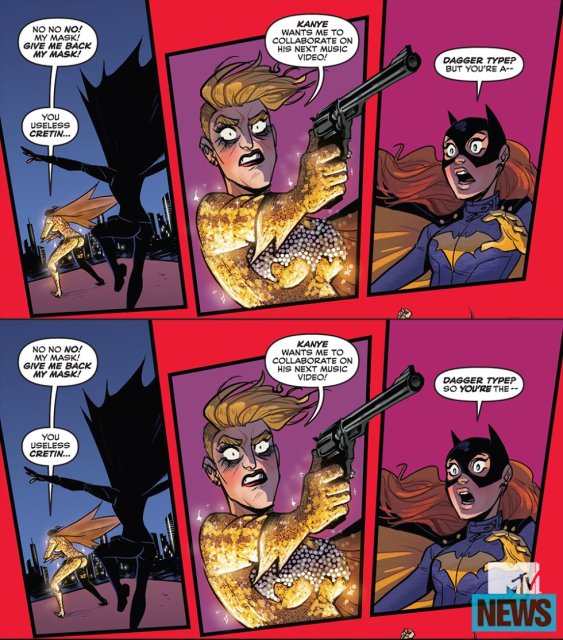
Some of the changed dialogue from Batgril #37 in the collected edition via MTV
Fortunately, while representation seemed to be slipping at DC and Marvel, another company quickly stepped in to become The Place to find quality trans representation in comics. Image, a company where creators retain the copyright to their own work, had been putting out award-winning comics by terrific writers and artists for years, so it made a lot of sense when some of these talented creators started including trans characters in their comics.
Already in May of 2013, Image started introducing trans characters into its comics. In Storm Dogs, by David Hine and Doug Braithwaite we meet a futuristic sex worker named Doll. While she is a “science fiction trans woman” in that she has a fully functional womb, something not possible for real trans women at this point, her depiction is still pretty realistic. In June of 2014, Joe Keatinge and Leila Del Duca’s series Shutter, an urban fantasy about the adventures of a semi-retired globally renowned explorer named Kate Kristopher, released its third issue, where we find out that Kate’s lifelong best friend Alain is a trans woman. While she’s not in a ton of the series, she still showed that a popular title at a popular publisher was willing to have a recurring character be trans. Similarly, Warren Ellis and Jason Howard’s series Trees introduced two trans characters in October of that year. In this science fiction series, the world has been covered in giant, tree-like aliens and we follow people’s lives in various cities affected by these “trees.” Trees #6, released in October of 2014, is about a man named Chenglei who meets and starts to fall for a woman named Zhen who tells him that she’s transgender and asks if he has a problem with that. While the writing is a little clunky, Chenglei realizes that he doesn’t have a problem with Zhen being trans and when he goes to his uncle for advice on life and love, he finds out that his uncle is actually a trans man. In January of 2015, another Image series, the punk rock D&D Rat Queens, written by Kurtis J. Wiebe, also revealed that one of it’s recurring characters, a fearsome orc warrior named Braga, is a trans woman in her own backstory issue, Rat Queens Special: Braga #1. When Tess Fowler took over as the artist for the book this summer, trans artist Tamra Bonvillain took over on coloring duties, making Rat Queens another book with both a trans character and a trans person on the creative team.

From The Wicked + The Divine #9 with art by Jamie McKelvie.
The most prominent example of trans representation in Image comics, though, comes from Kieron Gillen and Jamie McKelvie’s amazing The Wicked + The Divine. This series, which takes place in London, is about a group of gods who are reincarnated into the bodies of teenagers every 90 years only to live as the most celebrated of celebrities for two years and then die. The current group of gods, known as The Pantheon, features several queer characters, including one, Inanna, who is very gender non-conforming. Another character, Cassandra, is hinted at being a trans woman, and then is revealed to be one (in an apology for an earlier transphobic remark from the reincarnated Lucifer, no less) in The Wicked + The Divine #5, released in October, 2014. Later on, Cassandra, who is a journalist, biracial woman of English and Japanese descent, and one of The Pantheon’s biggest skeptics, is revealed to be the 12th member of The Pantheon, Urdr. Cassandra/Urdr is not only a well-fleshed-out character, but also one who features heavily in the book. The way the book handles her being trans, and other people’s transphobia, is also one of the best portrayals of a trans character so far in comics. Gillen told me that the desicion to have a diverse cast that included a trans woman was a logical one.
A lot of it just comes from wanting to write the people I know and the world I live in. I’m a Londoner. It’s 2015. I’d like the art we create to be as diverse as the city I love. I’m obviously pro-representation and understand how incredibly powerful it is for people to see themselves mirrored in art when they’ve rarely been before, and that’s certainly in the mix, but the biggest thing is just that I believe more diverse art is better art, as it shows more of the world inside it. With Trans issues specifically, there’s an element of due diligence too. You want to tread carefully. With WicDiv and Cassandra, for example, we specifically reached out to a friend who basically acts as a trans consultant on material that I worry about, which I’m enormously grateful for.
The Golden Age of Trans Characters (2015)
With Image comics going strong, DC and Marvel, as well as a new publisher to the game, Boom! Studios, started stepping up their representation, bringing in more and more trans characters and making them more and more diverse. It started to seem less like trans characters were just a gimmick and more like they were becoming a real part of the comics landscape.
Boom! Studios, which releases a lot of all-ages comics, had its first openly trans character in the form of Leo, from Madeleine Flores and Trillian Gunn’s fantasy/adventure/humor series Help Us! Great Warrior. This series started out as a webcomic and made the leap to physical comics in February 2015. Leo is the best friend and fellow warrior of the titular Great Warrior, and while the Great Warrior is a nonhuman blob (but a very cute one), Leo is a human, and is a trans woman of color. Leo marks an important point in comics, as she’s the first character confirmed to be trans in an all-ages comic (but not the first to appear; more on that later).
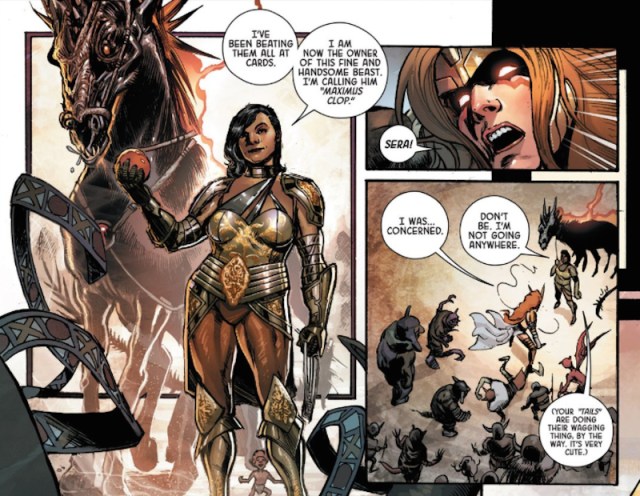
Sera talking to Angela. Art by Phil Jimenez
Also in February, Marvel Comics revealed that one of their characters was a trans woman. When Angela: Asgard’s Assassin #3, written by Kieron Gillen and Marguerite Bennett, and with art by Phil Jimenez and Stephanie Hans, shows the character Sera telling how she and Angela met, she explains that she was was born into the Anchorites, an all-male (except for the trans women who sometimes end up there) group from Heven, the home of the angels. One day she saw Angela come and slay a monster and she joined in and helped her. In return, Angela took her with her and Sera was free to be herself. As I said before, Sera, at this point, was the closest thing comics had to a trans superhero. In her current form, it looks like she might becoming the closest thing we have to a trans villain as well. Since then, Sera has again appeared as the second billed character in 1602: Witchhunter Angela and the current series Angela of Hel, where she and Angela shared not one, but two on-panel kisses.
One huge step for trans representation came in the form of Jem and the Holograms. In March, 2015, artist Sophie Campbell, who had been announced as the series’ artist, came out as a trans woman on twitter. Representation doesn’t just matter on the page, it also makes a big difference when you can see people behind the scenes who are like you. It helps you to see that you can do it too. For trans people everywhere, Campbell’s announcement was a big step in doing that. Not only is Campbell working behind the scenes as a trans woman, but she also created a new character for the series, Blaze, who she says is trans.

From Secret Six #4 with art by Ken Lashley and Tom Derenick.
Simone once again stepped up for her trans fans (and really, all of her fans), by introducing another trans character in her book Secret Six. Secret Six is about six strangers, some villains, some anti-heroes, some a little closer to heroes, who have been forced together and end up becoming sort of a chosen family. One of these characters is Porcelain, who has the power to make anything they touch turn hard and brittle. In Secret Six #4 (July 15, 2015) Porcelain, who had normally been presenting as fairly feminine, starts presenting in a more traditionally masculine way and explains to the team that some days they feel more like a man, some days they feel more like a woman. Once again, Simone wanted to make sure that all trans readers had someone they could look up to.
Porcelain identifies as non-binary, genderfluid. They’re another of my favorite characters, I love their sense of fun and showmanship. This again happened because there was a gap in representation. As more and more people come out as non-binary, it becomes clearer that the lack of characters who fit that description is quite glaring. So I asked of my readers who identify as such for help, and again, many, many readers were eager to help, which was lovely.
I was born on a farm, surrounded by rednecks. I’m still living in a small town with very little diversity. The willingness of readers to help is what has granted these characters whatever grace they have.
I really just want comics to be for everybody. There are a million comics out there with straight white casts and a hundred creators making more of them every day. I just think we can do better.
In my opinion, the three biggest moments in trans representation in comics are Rachel Pollack creating and writing Coagula, Alysia Yeoh coming out as trans, and this next moment. On August 26, 2015, Lumberjanes #17 came out and one of the main characters, a girl named Jo, came out as trans, making her the first trans protagonist of an all-ages comic, and perhaps the first trans protagonist of any mainstream comic. Lumberjanes is a very popular and very critically acclaimed series originally by Shannon Watters, Grace Ellis, Noelle Stevenson and Brooke A. Allen that’s won both Eisner and Harvey awards and sold over 65,000 copies of it’s first trade paperback in the first two months. This is a big moment. Not only is a popular comic, but it’s a very feminist one, and it’s all about girls being friends and going on adventures together.
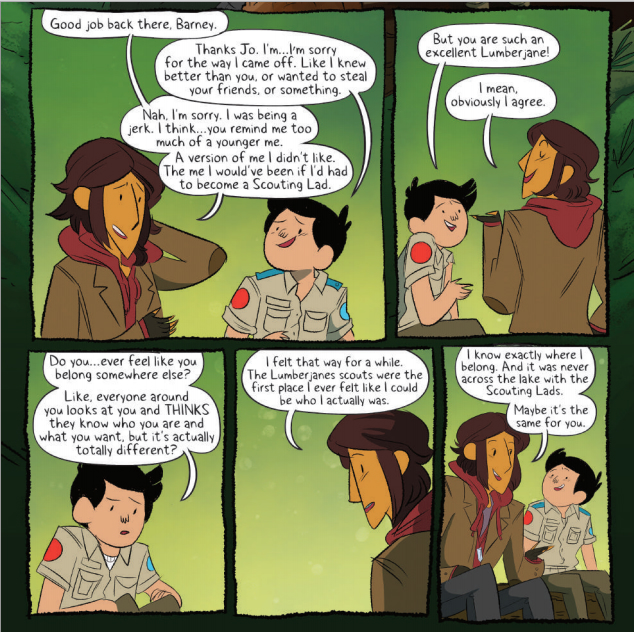
From Lumberjanes #17 with art by Brooke A. Allen.
Lumberjanes takes place at Miss Quinzella Thiskwin Penniquiqul Thistle Crumpet’s Camp for Hardcore Lady Types, where five girls — Jo, April, Molly, Mal and Ripley, and their counselor Jen — learn what it means to be friends and solve supernatural mysteries. And one of the girls that it includes is a trans girl of color. In Issue #17, Jo has a sit down with a boy from a nearby boy’s camp who’s been spending a lot of time with the Lumberjanes. She tells him that she’s been rude to him because he reminds her of a younger her, a version of her if she hadn’t been allowed to be who she is. She tells him that she found her place with the Lumberjanes and that if Barney ever feels like he doesn’t know where he belongs, he can be a Lumberjane too. It’s a very sweet moment, and a beautifully written and illustrated one (full disclosure: I consulted on the script for this issue), and it shows a trans character in a way that’s never happened in comics before.
Because this is an all-ages book, and because Jo is a real human girl who came out and transitioned like a real life trans person, Lumberjanes is doing something really special. They’re showing young trans kids everywhere that they belong, that they can be heroes, that they can find their place in the world. And they’re showing cis readers, hey, if the Lumberjanes are this welcoming and supportive towards trans girls, why can’t you be too? Watters, who co-created the Lumberjanes and co-wrote this issue and was also the editor for Help Us! Great Warrior, knows that representation is especially important in all-ages media.
Trans representation is so vital in all-ages media because the opportunity for trans youth to see themselves represented positively can literally be a life or death issue… so many queer kids struggle with the idea that they’re damaged because they fall outside of the “normal” that surrounds them in pop culture every single day. For some, that can be too much to bear. And what is “normal” if not seeing the deepest parts of yourself reflected honestly, and beloved? A character whose depiction reiterates the truth: you, like them, have value and worth. All-ages comics are accessible, and personal…easy to throw in a backpack or stash under a pillow, easy to read the pictures if not the words. Trans representation there can be held close, just for each and every trans kids to flip back to when they need it most, reiterated time after time. You have value, you have worth, you are loved. I hope in the future, more creators and publishers see that, and respond creatively.
So, Jo was trans when she first starred in Lumberjanes #1 back in April of 2014, making her the first trans character in an all-ages book, but since she didn’t come out as trans in the book until this summer, Leo from Help Us! Great Warrior was openly trans before her.
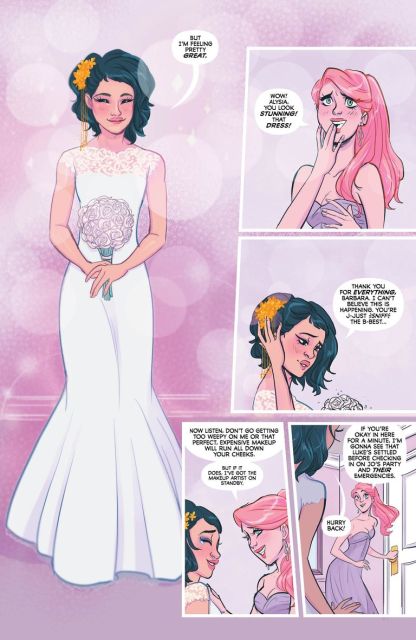
From Batgirl #45 with art by Babs Tarr.
Over at Batgirl, Stewart, Fletcher and Tarr started shuffling Alysia Yeoh back into the fold, even having her get married to her girlfriend, Jo, in an issue that was mostly about that wedding. Alysia announced her engagement to Jo in Batgirl #42 and then later rescued her from the claws of Velvet Tiger in issue #44, but it was Batgirl #45, released October, 28, 2015, where we got to a trans woman of color walk down the aisle and actually have a happy romance (something that Simone previewed in her alternate future story Batgirl: Future’s End #1). In both reality and the media we usually see trans women, especially trans women of color, being unable to find happiness and romance, so seeing Alysia, the first major trans character in a mainstream comic, smiling in a wedding dress was a big moment.
The Future
It’s extremely strange to see that the vast majority of actual trans representation — representation that doesn’t involve shapeshifters, body swaps, futuristic technology or magic — has happened since 2013. Now, of course, there are still some problems with transphobia and bad representation but those are becoming more and more rare. Instead, we get creators like Kelly Sue DeConnick saying she’s going to have trans characters in her Image comic Bitch Planet and artist Erika Henderson hinting at a trans character in The Unbeatable Squirrel Girl.
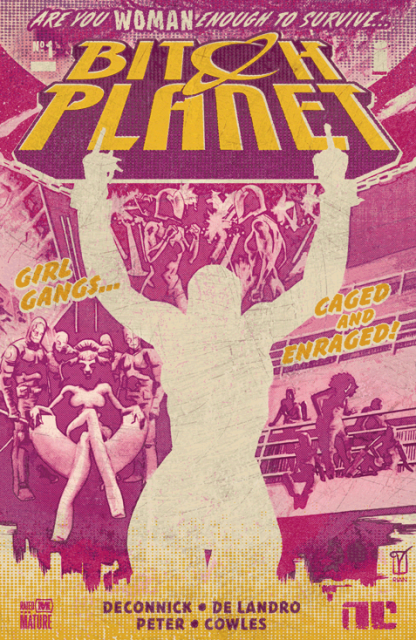
Bitch Planet #1 cover by Valentine De Landro.
As more and more trans characters are introduced into comics, the discussion is starting to shift from just the desire for representation, or even the desire for good representation to the desire for great representation. Who’s going to be the trans Wonder Woman, the trans Alana and Marko, the trans Ms. Marvel?
A few characters that are already appearing in comics feel like they could be that kind of character. Jo from Lumberjanes is a terrific character in one of the best all-ages comics around and Alysia Yeoh, who was never “just” a groundbreaking character, is a fan favorite with a ton of potential. But the next step is a trans character with their own solo title, a trans character who’s a clear standout in a team comic, a trans character who’s popular enough to get an action figure.
Another thing that the current Golden Age of Trans Comics is missing is someone who’s a true superhero. Sera comes close, so does Porcelain, but it’s going to be something else when we see a character who’s out there regularly fighting supervillains, hanging out with other super heroes and saving the day. It’ll also be amazing to see a trans supervillain, one who’s villainy has nothing to do with them being trans.
Comics also aren’t just about the actual comics anymore, they’ve permeated all of pop culture. Trans comic characters need to do the same thing. Currently there are five live-action TV shows from DC Comics (with another three coming out soon) and five more from Marvel (also with another three coming soon). Both companies also have several animated shows. With Marvel’s Jessica Jones, we’re finally seeing openly queer characters. Seeing trans characters make that same leap is one of the next logical steps in positive representation.
There’s also the ever-expanding world of comic book movies. Marvel and DC alone have over 25 movies planned over the next five years. However, seeing as only DC movie (Wonder Woman) and one Marvel movie (Captain Marvel) are starring women, it’s unlikely that a trans character will be introduced very soon. There’s still some hope for trans characters on TV and in movies, though, as The Wicked + The Divine has been picked up as a TV show and Lumberjanes has been optioned as a film.
Of course, another positive step that I’d love to see is more trans creators. Just like it’s impossible to know an accurate number of trans people in the general population, it’s impossible to know how many trans or gender non-conforming people are actually in the comics industry, but Sophie Campbell and Rachel Pollack are pretty much the two main names that are well-known, with others like Maddie Blaustein and Tamra Bonvillain also providing valuable additions to trans representation in comics.
We also need to see even more diversity. While it’s terrific that so many of the trans characters so far have been TWOC, there need to be more Black and Latina trans characters (these two groups of trans women are the most targeted group of trans people when it comes to anti-trans violence), more non-binary trans characters, more trans kids, more elderly trans characters, more trans men, some disabled trans characters, some fat trans characters.
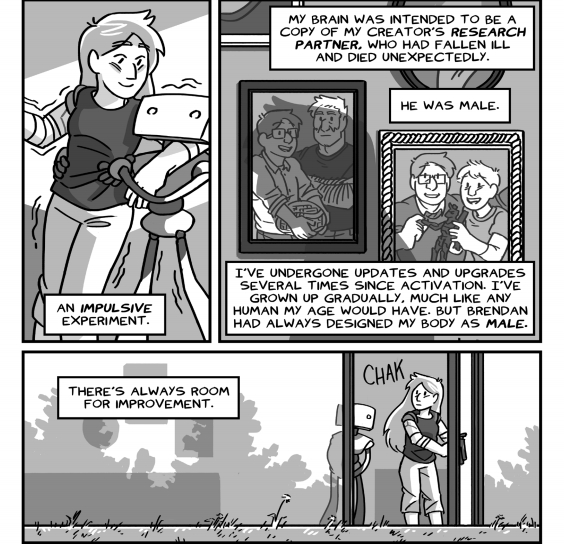
From “Optimal” by Blue Delliquanti in the Beyond Anthology.
When it comes to crowdfunded, online, small press or self-published comics, there’s much better representation. Sites like Kickstarter and IndieGoGo have helped facilitate the rise of a new generation of not only trans characters, but trans creators. Anthologies like Beyond, The Oath Anthology of New Heroes, Love in All Forms and Chainmail Bikini all were able to be published because of crowdfunding sites and all feature some terrific comics by and about trans people. These kind of comics are presenting an entirely new landscape in which we’re seeing a new kind of trans representation by the trans people, of the trans people and for the trans people.
The future is definitely a wonderful place. Rachel Pollack told me, “What’s happened in just the last couple of years is amazing and wonderful. I’m so excited to be around to see it and take part in it,” and I agree. On one hand we’ve got small presses and crowdfunding, which are giving trans creators more power and trans readers more access than they’ve ever had before. On the other, we’ve got indie and mainstream comics in the hands of writers, artists and editors like Shannon Waters, Sophie Campbell, Marguerite Bennett, Kieron Gillen, Kelly Sue DeConnick and Gail Simone who are making sure trans readers get the representation they deserve. If things continue to go the way they’re going, we’re sure to see not only the number of trans characters grow, but also the quality of their stories and personalities to grow. More and more writers are coming from a default starting position that includes trans characters. As DeConnick told me, the only reason she needed to include trans women in her feminist powerhouse comic Bitch Planet is “because they’re women.” Trans characters should be included in comics because because real life has trans people trans people are human and because trans people read comics. Most people who read comics are looking for a hero to look up to or a world they can escape into. Now that three dimensional, well-written trans characters are finally starting to appear in comics, trans readers everywhere can do that too.
Campaigns to Look Out For
In this section I’m going to highlight crowdfunding campaigns that you can support if you’re looking for more comics featuring positive representation for LGBTQ women.
Sophie Campbell’s Shadoweyes: Volume One Kickstarter is still going on for a little while longer. If you’d like to see this terrific comic from one of the best artists working in comics today, you still have a week and a half to do so.
Campaigners, by writer Brendan Hykes and artist MJ Barros, is set 50 years in the future when, instead of debates, Presidential candidates fight to the death to see who will lead America. A teenage girl named Kydra Franks stands up against the system and becomes a viral sensation. When her best friend, a trans girl named Bee, uses Kydra’s fame to find her own notoriety, all hell breaks loose. This project seems like it could be really cool and it needs a lot of support right now, so go check it out!
New Releases (November 18)
Jughead #2 (Archie Comics)
Adventure Time with Fionna and Cake Card Wars #5 (Boom!)
Lumberjanes #20 (Boom!)
Buffy the Vampire Slayer Season 10 #21 (Dark Horse)
Catwoman: A Celebration of 75 Years (DC)
Harley Quinn #22 (DC)
Secret Six #8 (DC)
Jem and the Holograms #9 (IDW)
Orphan Black: Helsinki #1 (IDW)
Phonogram The Immaterial Girl #4 (Image)
Pretty Deadly #6 (Image)
Rat Queens #13 (Image)
Shutter #17 (Image)
A-Force Volume 0: Warzones TPB (Marvel)
Captain Marvel and the Carol Corps TPB (Marvel)
Mighty Thor #1 (Marvel)
Ms. Marvel Vol. 4: Last Days TPB (Marvel)
Ms. Marvel #1 (Marvel)
Spider-Woman #1 (Marvel)
Star Wars #12 (Marvel)
Welcome to Drawn to Comics! From diary comics to superheroes, from webcomics to graphic novels – this is where we’ll be taking a look at comics by, featuring and for queer ladies. So whether you love to look at detailed personal accounts of other people’s lives, explore new and creative worlds, or you just love to see hot ladies in spandex, we’ve got something for you.
If you have a comic that you’d like to see me review, you can email me at mey [at] autostraddle [dot] com.
Pages: 1 2 3See entire article on one page



This was fascinating to read. Thanks for showing us how far we’ve come in terms of trans representation.
Mey, this is incredible.
Really satisfying to read through too!
Comics, especially away from the Big Two, are such an exciting place to be in the past few years: it’s a momentum, with a new generation of creators, that feels unstoppable.
And within the Big Two, the love and sincerity behind the epic fantasy-romance that Angela and Sera are shaping up to be is just extraordinary; and the tragedy, the ups and downs, the heart in your mouth genre drama and silliness, if you will, feels like something I can expansively embrace without the fear that who Sera is will be betrayed. Or that the relationship between these two women will be undersold. When you have to be so guarded in your life, it’s so nice to be able to just float in breathy-sighs and giggle a bit.
Wow. This is a masterwork, Mey!
This is so rad! I can’t wait to see the continuation!
Could I also recommend the comic Storm Dogs from Image, by David Hine and Doug Braithwaite?
http://www.bleedingcool.com/2013/05/08/gender-sex-work-and-going-beyond-diversity-natalie-reed-storm-dogs-5-print/
Oh, cool, i hadn’t heard about this and didn’t see anyone else talking about this as an example of trans representation. Thanks for pointing me toward it!
This is amazing! You’re so knowledgeable about comics, we’re all lucky to get to read your writing about them.
This is an awesome article, Mey! Thank you so much for the mention. :D One thing I was surprised wasn’t included: ‘Deathwish’ was created and written by Maddie Blaustein, a trans woman, who is sadly no longer with us. She was also the voice of Meowth from Pokemon!
Thanks! And Sophie, you’re totally right! I can’t believe I left her out! When I first came up with this idea and was making a list off the top of my head I thought “oh, i need to mention that woman who voiced Meowth” not being able to remember her name or what comic she wrote, but then when it came to actually write it, I somehow left her name off! I’ll add it in right now! Thanks
Fantastic, Mey!
Samuel Delaney’s takedown of that Sandman comic in his introduction to A Doll’s House is the most beautiful damning with faint praise I have ever read.
Nice overview Mey, you may also want to look at Welcome Back (issue #3 out this week) which features two soldiers who are reincarnated over and over into different bodies, both male and female. Also highly recommended is Flutter from 2013 about a girl with powers who meets a girl she likes and shape-changes into the girl’s ideal boy. It gets very complicated for her after that, but the first volume is very good. There is also a second volume that came out recently, but I haven’t read that yet.
For this week there are a few other comics with female or LGBT lead characters that everyone might be interested in.
– Clean Room #2 by Gail Simone. A woman is trying to bring down a self-help guru who she believes killed her fiance. Too early to tell how this one will turn out.
– Wayward #11. This is an interesting series set in Japan and delves into a lot of Japanese mythology. 5 teenagers with mystical powers are the lead characters and there have hints of romance between two of the girls.
– Vader Down #1. Marvel’s first Star Wars crossover as the rebels lead by Leia try to take out Vader while Aphra and her droid sidekicks try to rescue him.
– Cognetic #2. The lead character is a lesbian, although her wife and daughter have only been “seen” when she makes a phone call.
– Giant Days #8. I still have to catch up on this one, but I’ve heard it’s good.
– Welcome Back #3.
Here’s a site that lists more pre-2002 (last time the owner updated it) depictions in comics:
http://www.tgfa.org/
THIS RULES!! I was spoiled on Lumberjanes, but that’s okay and actually exciting because I was really hoping for a trans character in that comic and to have it be real just… jadlkfjghagh!! I can’t wait to catch up and then lend the new trade to my young friend (former nanny charge) who loved the first trade and wants to be a Lumberjane.
And wow. This is a masterwork. Thank you for all of your research and dedication! I’m now going to spend the remains of my snow day getting caught up on Lumberjanes, Shutter, and WicDiv.
Oh! And I was super thrilled to learn that Kate Godwin was named for Auntie Kate! What a great tribute to an incredible person!
This is a great article! I didn’t realise Jo from Lumberjanes was trans, and that’s good to hear – though I have to admit it really doesn’t interest me in going back to Lumberjanes.
I’d like to add a comic that’s missing from this, which is Gary Reed and Guy Davis’ excellent Baker Street, which has a trans main character. It’s a little… typical in what happens to her (I won’t say more), but I appreciated her being there all the same and it worked really well for the comic.
Thanks for letting me know about Baker Street!
Wow! Super informative and well written Mey! I learned a lot!
Thank you, Mey! This is wonderful. And I almost tweeted Kelly Sue DeConnick when I finished reading Bitch Planet, vol.1 to ask her if she was going to include trans women in future issues, but I kept going over the character limit in my tweets and gave up, haha. Happy to see I didn’t have to tweet her about it after all!
Wow. Wowowowow, Mey. This is incredible. I don’t even know that much about comics and I enjoyed reading this. In fact, it makes me want to read more comics…The Wicked & The Divine, in particular.
Thank you for this, it’s awesome!
Lord Fanny is a highly problematic character, but I’d categorize her as am actual trans woman. While it’s true her grandmother says she’ll raise the child as a woman to carry on the witch lineage, it’s not accurate to say she forces Fanny, either to be a girl or a witch. Throughout the issue on Fanny’s backstory, Fanny embraces and pursues feminine/witch expression/identity wholeheartedly and of her own volition.
There’s also a point later in the comic series where Morrison almost has Fanny say that genitals don’t determine gender, but he doesn’t commit and her line gets cut off by another character interrupting.
Batgirl and Bitch Planet have been on my to-get list and now I’m dying to read them ASAP! And Rat Queens! ACK!
This is awesome! Thanks for writing this, Mey!
I thought about chiming in with several recommendations for webcomics with trans characters (I’m a big webcomics reader), but now I’m hoping that will be another post…
Wow, some of these entries bring back dubious memories. Kudos on the incredibly comprehensive meta-analysis.
This history is perfect except for the fact that I’M not in it ^_____^
This misses out some 50s comics such as:
TRANSFORMATION
http://pappysgoldenage.blogspot.com.au/2009/10/number-606-no-longer-science-fiction.html
TRANSFORMATION COMPLETED
http://www.gayleague.com/comics-archives/transformation-completed/
also, in Gay Comix:
I’M ME!
http://imgur.com/a/a9koG#0
Fantastic list, thank you for putting it together. While there are certainly issues with Gaiman’s depiction of Wanda in The Sandman, I think some of the criticism is misdirected. Gaiman has stated quite clearly that the reason the Moon refuses to see Wanda as a woman was because he was specifically critiquing transphobia he’d observed in early 90s pagan communities. The effectiveness of that critique, or how it’s interpreted through a modern lens, well, that’s always up for debate.
Excellent!
Thanks for mentioning my Shining Knight. I let the Knight’s exact status remain vague, apart from their statement they were ‘both’, several other references to that effect, and my instructions to the artists, because I didn’t want to exclude *anyone* who identified as trans. It’s all there on the page, though, not something readers have to find in subtext. Good article. I loved Doom Patrol.
What a great article, I’m glad I took the time to read it. I’ve been mildly interested in Help Us! Great Warrior and now that I’ve been informed that there’s a trans woman in it I think I’m going to try it.
Fantastic article. One small quibble though. The picture of the Ultra Humanite that you have in the beginning of the article isn’t from Action Comics #20 nor is the art by. Joe Shuster. I have a scan of the actual page if you wish to use it.
Seems that you conveniently forgot that at the very end of “A Game of You” that Death sees Wanda completely as a woman. I remember Gaiman getting flak for how some random moon Goddess sees Wanda, Gaiman responded by saying that the way Death sees Wanda is what matters and that he agrees with Wanda about Gods and Goddesses sticking it up their sacred rectums. You also act like Gods and Goddesses matter in that series when it’s said over and over again that they only exist because we believed them into being, so how important is a God or Goddess if that is the case.
I also know that “A Game of You” was a catalyst for changing how comic readers saw trans people but I lament that they had to change artists halfway through and the new artist had no idea how to draw a trans person who had been on hormones for a long time.
Not sure if they count as Trans but the character Cloud (who was in reality a personified nebula with amnesia) from the Defenders in the late 80’s was able to manifest their physical form as both biological male and biological female.
Wonderful article!
Point of order though- that panel of the Ultra-Humanite was drawn by Kurt Shaffenburger, who drew Superman (and Superboy) for many decades, starting in the 1950s.
If you are looking for printing services in Ahmedabad, then look no further as we are here to help. Get in touch with us to know more about a wide range of printing services and prices.
Is there any chance of including Coagula from Doom Patrol (first introduced in 1993) by trans creator Rachel Pollack?
As far as I can tell she’s DC’s first actual trans superhero character (as opposed to shapeshifters, body-swaps etc.) and it would be good to see her represented.
Excellent post !
This is the best blog so far
This is best blog.
Skincell Pro is a powerful serum made from natural ingredients. With just a few drops applied to a blemish, the serum works to penetrate to the root of a mole or skin tag.